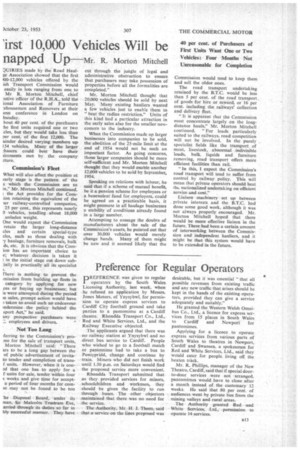irst 10,000 Vehicles Will be
Page 47

If you've noticed an error in this article please click here to report it so we can fix it.
napped Up Mr. R. Morton Mitchell I.JIRIES made by the Road Haulge Association showed that the first 100-12,000 vehicles offered by the ish Transport Commission would easily in lots ranging from one, to Mr R. Morton Mitchell, chief :utive officer of the R.H.A., told the ional Association of Furniture .ehousemen and Removers at their imn conference in London on inesday.
bout 40 per cent. of the purchasers be first units required one or two Lies, but they would take less than per cent, of the first 12,000. The ainder desired varying numbers up 154 vehicles. Many of the larger :hasers could best have their iirements met by the company cture
Commission's Fleet
What will also affect the position at early stage is the pattern of the s which the Commission are to in," Mr. Morton Mitchell continued.
the Act provides for the Cornion retaining the equivalent of the ier railway-controlled companies, 25 per cent., this represents nearly 0 vehicles, totalling about 18,000 unladen weight.
One would expect the Commission retain the larger long-distance cies and certain special-type cies, such as those dealing with y haulage, furniture removals, bulk ds, etc. It is obvious that the Comion has an important choice to e; whatever decision is taken it t in the initial stage cut down sub:laity in practically all its specialist 3.
There is nothing to prevent the [mission from building up fleets in category by applying for new ces or buying up businesses; but is were attempted during the period le sales, prompt action would have taken to avoid such an endeavour mdermine the policy behind the sport Act," he said.
any prospective purchasers were 2. employees and drivers.
Not Too Long
ferring to the Commission's prome for the sale of transport units, Morton Mitchell said: "There ars to be a long gap between the of public advertisement of invitato tender and completion of transf units. However, when it is coned that one has to apply for a f units for sale, tender within four t weeks and give time for accepta period of four months for cornm may not be found to be too he Disposal Board, under its man, ir Malcolm Trustram Eve, arried through its duties so far in Lily successful manner. They have cut through the jungle of legal and administrative obstruction to ensure that purchasers may take possession of properties before all the formalities are completed."
Mr. Morton Mitchell thought that 20,000 vehicles should be sold by next May. Many existing hauliers wanted a few vehicles just to enable them to " beat the radius restriction." Units of this kind had a particular attraction in the early sales also for the smaller newcomers to the industry.
When the Commission made up larger businesses into companies to be sold, the abolition of the 25-mile limit at the end of 1954 would not be such an important factor. As going concerns, those larger companies should be more self-sufficient and Mr. Morton Mitchell thought that they would enable another 12,000 vehicles to be sold by September, 1954.
Speaking on relations with labour, he said that if a scheme of mutual benefit, be it a pension scheme for employees or a benevolent fund for employers, could be agreed on a practicable basis, it might promote in all haulage businesses a stability of conditions already found in a large number.
Attempting to assuage the doubts of manufacturers about the sale of the Commission's assets, he pointed out that over 30,000 vehicles would merely change hands. Many of them might be new and it seemed likely that the Commission would tend to keep them and sell the older ones.
The road transport undertaking retained by the B.T.C. would be less than 5 per cent. of the road transport , of goods for hire or reward, or 16 per cent. including the railways' collection and delivery fleet.
"It is apparent that the Commission must concentrate largely on the longdistance hauls," Mr. Morton Mitchell continued. "For loads particularly suited to the railways, road competition will not be involved. In the purely specialist fields like the transport of meat, livestock, abnormal indivisible loads, bulk, liquids and furniture removing, road transport offers more efficient facilities than rail.
"In this, I expect the Commission's road transport will tend to suffer from control by railway policy. This will mean that private operators should beat du. nationalized undertaking on efficient service and cost."
Liaison machinery set up between private interests and the B.T.C. had done some good work, although it was not always properly encouraged. Mr. Morton Mitchell hoped that there would be more effective liaison in the future. There had been a certain amount of interworkiog between the Commission and independent hauliers, and it might be that thissystem would have to be extended in the future.




































































































